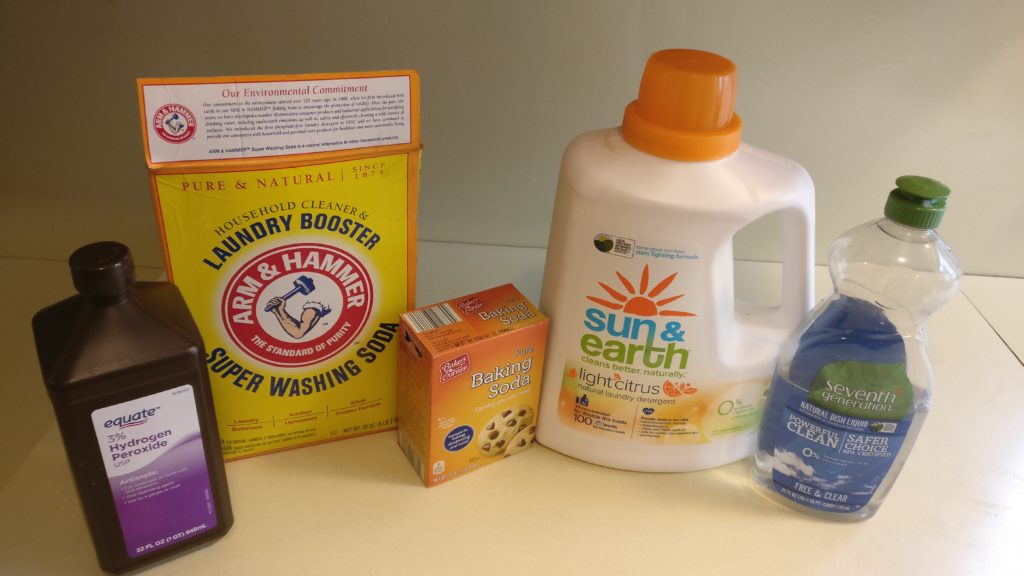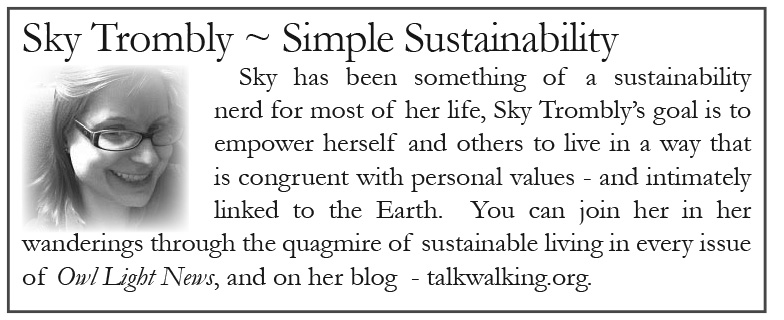Simple Sustainability: The Zen and Art of Cleaning Less
by Sky Trombly –
I like cleaning as much as the next person, which is to say, I don’t. That said, most of us appreciate the outcome of cleaning.
Clean spaces are refreshing and peaceful… and more hygienic.
One of the most compelling promises of minimalism was the prospect of having to clean less. Cleaning less doesn’t happen automatically when you subscribe to minimalism, it is an art form that I’ve had to learn. Now, I hope to share the secrets with you.
Step 1: Tidying
The first step to cleaning less is to tidy and the first step of tidying is to purge those things from your house that you no longer want or need.
This is probably not a surprise. We are most familiar with the minimalist tendency to purge unwanted stuff. It stands to reason that the fewer things we own, the fewer things we’ll need to clean.
Practically speaking, decluttering is both an event and an ongoing practice. After the initial pare down (the event), it is necessary to keep checking in with ourselves about how we now feel about our stuff and to keep the newcomers in check (an ongoing practice).
The second element of tidying is organization. Organization is not cramming large quantities of stuff into pretty little boxes and putting those boxes on the shelf. At its root, organization is all about giving our (wanted) stuff assigned seating, a home within our homes.
When we pick something up, we should know to where it needs to be returned. This makes things more automatic (quicker) and requires less thought (less decision fatigue). It also means we’re less likely to lose our car keys.
I find the easiest way to stay on top of this is to do regular tidying sessions. By “tidying”, I mean tracking down toys and shoes and jackets and returning them to their homes. If I pick something up and it doesn’t have a home it gives me pause. Maybe it isn’t worth keeping. In fact, this is when I do that ongoing purge practice I wrote about above.
Since most things are just automatically returned, I have saved myself the decision-making time and energy to use on any newcomers to my domain. I ask myself if these new arrivals really deserve to stay. If they do, I give them a home. If they don’t, out they go.
I can afford to make executive decisions on most stuff coming in, but when it comes to what my housemates drag in, I put the new items in their own personal spaces (unless the new things are obviously garbage). This keeps communal spaces decluttered.
Step 2: Cleaning
It’s hard to wash a counter when it’s covered in dishes, garbage, and your child’s homework. That is why tidying is the logical first step. That said, if we never get to actually cleaning our home, the accumulated filth will make us sick. It is the sad, inescapable truth.
I knew I didn’t want my cleaning process to be toxic or complicated, so I’ve put some thought into the kinds of cleaning products and tools that I like. In order to keep my cleaning routine simple, I rent (instead of buying) specialized and rarely used tools such as carpet and steam cleaners.
 This isn’t earth-shattering, but every item is durable and, of course, reusable. I skip out on the paper towels and Swiffer pads and that sort of thing.
This isn’t earth-shattering, but every item is durable and, of course, reusable. I skip out on the paper towels and Swiffer pads and that sort of thing.
 I have chosen these cleaners over several years based on their low safety concerns. (The exception is the bleach.) I evaluated safety concerns based off of the Environmental Working Group’s Database, an online public service resource worthy of checking out.
I have chosen these cleaners over several years based on their low safety concerns. (The exception is the bleach.) I evaluated safety concerns based off of the Environmental Working Group’s Database, an online public service resource worthy of checking out.
Step 3: Tackling the cleaning schedule
I tried working through complicated cleaning schedules and just as soon as I had invested the time and energy developing them, I would forget them. I also would get off track easily due to caring for a sick child one day and then vacation the next.
I needed a cleaning schedule that was always relevant and flexible.
I broke my house down into manageable sections based on the square footage and the relative amount of work. As I have a large home with a large family, this means four sections. I devote 15 minutes to tidying and cleaning each section.
I set a timer and get as much work as I can get done. It also keeps my heart rate up as I race the clock, which I hear is good for you.
I start with tidying, scanning the areas for stuff that is out of place and putting stuff where it belongs. Then, I take my cleaner’s caddy out and tackle the cleaning jobs that jump out at me. Not every cleaning job gets done each day, but most important tasks do get done during the week.
This strategy relies on consistency. The first day the kids are back at school, I might take the whole 15 minutes picking up toys, but by the end of the school week, I might be addressing door handles and the crumbs underneath the couch.
My daily hour does not include a few things. It does not include laundry, dishes, cooking, grocery shopping, bill pay, and yard work, for some examples. I eat every day and try to incorporate washing dishes as I do my food preparations. I also have to do 2 loads of laundry each day in order to keep up with the kids and with cloth diapering. The other items get done about once per week, outside of my basic cleaning schedule.
But am I actually cleaning less?
For someone who hates cleaning as much as I do, the question remains: how often do I need to tidy and to clean to maximize my benefits in the face of my laziness?
Unfortunately, I found the simplest answer to be: more often than I used to, but with far less elbow grease.
The unspoken fact is that when you have less underwear, you do laundry more often (because you must) and when you have fewer plates you wash them more often (because you must).
The benefit is that when you wash that underwear, it isn’t mildewy and when you wash those plates, there isn’t hardened-on mold. Jackets stay cleaner because they are hung instead of walked on. You get the picture.
Some of you might be feeling a little misled: the article did promise “cleaning less”. But bear with me and this unpalatable news.
In my case, the result of consciously deciding how much cleaning and upkeep I was comfortable with meant I was doing more than before. I hadn’t been comfortable with the amount I wasn’t doing. I needed to “up” my cleaning game.
That said, cleaning is a lot easier than it once was. I am in a routine of glancing over my surroundings for things that are out of place and putting them away or discarding them. I find it easy to straighten and to wipe down surfaces so that, for example, dinner is served on a clean table. I don’t sweat figuring out the best cleaning solution to apply. My house is typically visit worthy and even if I skip a day of cleaning I haven’t lost my place in a “cleaning schedule”.
Though I am cleaning more (and more easily), it doesn’t mean that this will result in more cleaning for everyone. I have 6 people (+ pets) living here, 3 of whom are still too young to help out effectively. You could, for example, assign areas of the house for greater equity. If you don’t have small children, you may find 15 minutes in each area excessive because you don’t spend 10 of that cleaning up toys and other stray items they brought in with them. If you live in a smaller home, you might have fewer zones overall to do. Laundry might be a once-a-week chore for your household.
In turning the methods of minimalism onto the cleaning task, I have discovered that I am cleaning more. The secret is that it doesn’t feel like it. Sure, when I get up I now take my mug out with me, and I might be cleaning microscopically throughout the day. But everywhere I look, there is greater satisfaction to be had. That, I guess, is about as Zen as it gets.
